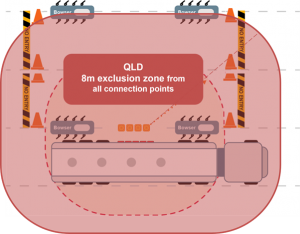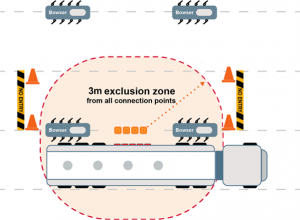The EPA has released amended guidance to fuel transport and fuel retail operators to highlight the importance of compliance with the broadened exclusion zones and heightened risk control measures that are required to be adhered to when a fuel tanker is delivering petrol to a site. This guidance ensures there is no confusion over the manifold nature of responsibility for controlling ignition risks with a view to ensuring that site operators, site staff and delivery drivers are all ‘on the same page’ in terms of compliant delivery requirements.
The delivery of petrol to an active retail site is an activity that dramatically increases almost all of the risks on site, particularly the risk of fire due to the increased presence and disbursement of petrol vapor. This increased risk is managed by ensuring that in the first instance the risk is recognised and communicated to those able to address it, and in the second instance, by preventing the introduction of ignition sources into the hazardous zones created by the fuel tanker discharging. While incidents involving fuel tankers discharging at retail sites are rare, they can have devastating consequences when they occur.
In late February 2023, a fuel tanker was discharging at a retail site and a fire started that burnt the tanker, the three cars on site and entire site to the ground and melted cladding on nearby homes. This particular incident is under investigation by WorkSafe NSW, EPA NSW and FNSW with the causes and learnings yet to be released.
“There will be a raft of lessons to learn from this incident, we will have to wait for those to come out in the fullness of time, once the investigations are complete. What we can do right now however is ensure that we are getting the important things right now. That means reviewing site emergency response plans, ensuring that site staff are trained on what to do when a tanker is on site, ensuring that site staff are trained on what to do in the event of an emergency and ensuring that there are off-site copies of all manifests, tank drawings and site plans for provision to responders and investigators”, explained ACAPMA’s Elisha Radwanowski.
“Safety of people and the environment has always been key for fuel transport and retail, and the incident in February this year triggered an action point for the various regulators that cross the industry. At the time ACAPMA reminded fuel transport companies that Transport Emergency Response Plans (TERPs), driver training and exclusion zone management, always a focus of regulators, would likely increase in terms of enforcement activity in the wake of the incident”, continued Elisha.
Similarly on the retail side the training of staff on tanker discharge situations, what is and is not the console operator’s responsibility, what to do in an emergency and importantly the operational instructions regarding the increased exclusion zones during tanker discharge are key areas of focus of the regulators.
“Retail site operators need to ensure that they have reviewed the delivery plans for their site, and they know if a lane needs to be shut down during when a fuel tanker is filling the underground tanks with petrol, or if the whole site needs to be shut down during that filling process. Cars and customers must be kept out of the expanded fuel delivery hazardous zone. This is because their engines must be seen as an ignition source that could lead to a fire during the filling process, so they have to be kept out of that zone to reduce the chance of a fire. As a result, it is not uncommon, particularly in older smaller sites, for the operation of a fuel tanker filling the underground tanks with petrol to require the whole site to be shut down”, continued Elisha.
The hazardous zones and exclusion zones that apply on a fuel retail site change depending on the fuel, the conditions and jurisdictions.
“For most of the country when a fuel tanker is delivering one of the petroleum grades into an underground tank, the requirement is for an area 3m around from the filling connection to be counted as a high risk or hazardous zone, and for all ignition sources to be kept out of that zone for the duration of the filling time and for five minutes after”, explains Elisha.
NSW – Exclusion zone when a petrol tanker is unloading.
illustration purposes only, not to scale.
The requirement is different in Queensland however, where that exclusion zone is 8m around from the filling connection. This distinction is important to understand, particularly for operators who are based in border regions.
“While the EPA NSW guidance is transferable to most States it is very different in Queensland and operators on both the retail and transport side need to have an appreciation for this difference”, continued Elisha.
 QLD – Exclusion zone when a petrol tanker is unloading.
QLD – Exclusion zone when a petrol tanker is unloading.
illustration purposes only, not to scale.
“What is common across the country is that fuel tanker drivers are not allowed to deliver if it is unsafe, that includes if the ignition sources are not being managed appropriately, and they face penalties if they do deliver in an unsafe environment. On the other side fuel retail staff and operators face penalties if they obstruct the driver in making the delivery safe.
“The driver is responsible for ensuring that the tanker is parked in the appropriate place and facing the appropriate way. The driver is also responsible for putting out cones or barricades to indicate the appropriate exclusion zone. The staff on site at the service station are responsible for ensuring that customers do not enter the exclusion zone and that pumps are shut down where appropriate. Site operators are responsible for ensuring that their staff understand their responsibilities. Everyone has their role to play in ensuring a safe and compliant delivery”, concluded Elisha.
The EPA NSW recently wrote to all fuel transport operators following a recent series of investigations. This communication highlighted the basic requirements around ensuring sufficient ullage in a tank before delivering, keeping tanker hoses and connections in good condition and the need to exclude persons and ignition sources from the exclusion zone while delivering. This communication also identified that “with regard to unloading at petrol stations, EPA officers have identified instances where cares are not being prevented from entering the exclusion zones and petrol pumps have remained in operation in lanes adjacent to the outlet side of unloading tankers. This is unsafe and unlawful. To make it easier for both drivers and forecourt operators to understand the exclusion zone requirements please see …tanker unloading fact sheet”.
The EPA NSW Guidance is available online at: epa.nsw.gov.au/your-environment/dangerous-goods/preventing-fires-truck-inspection-manual.
Here to help
Safety Highlights are things to consider, implement and watch out for in your business. They are provided as general information for you to consider and do not constitute advice. You should seek further advice on your situation by contacting your legal advisor. ACAPMA members can access resources and receive advice, guidance and support from the ACAPMA employment professionals via employment@acapma.com.au, it is free for members. ACAPMA Membership delivers this and more benefits, see https://acapma.com.au/membership/ for more information.
Elisha Radwanowski BCom (HRM & IR)
ACAPMA
Source: EPA targeting fuel delivery exclusion zone violations – ACAPMAg.






